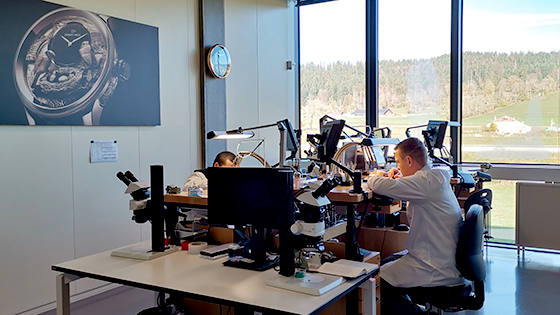
Where the magic of watchmaking comes to life... Some 30 workshops, Manufactures and institutions opened their doors to the public from 31 October to 3 November this year. This 11th edition of the Watch Heritage Biennial once again revealed the teeming ecosystem of time measurement, giving 4,500 curious visitors the chance to discover what goes on behind the scenes.
After a three-year absence, the Watch Heritage Biennial gave the public an opportunity to delve into the heart of the art of watchmaking. In all, 16 watchmaking companies, 15 subcontractors and schools along with 12 cultural institutions held open days in La Chaux-de-Fonds, Le Locle and Saint-Imier.
Supported by the FH, alongside the Banque Raiffeisen des Montagnes neuchâteloises and the Loterie romande, the event attracted 4,500 watchmaking enthusiasts and novices alike, all sharing a love of measuring time.
As soon as they went online, the available places were snapped up. Renowned Manufactures such as Zenith, Cartier, Eberhard & Co, Audemars Piguet, Girard-Perregaux, Longines, ochs und junior, Jaquet Droz, TAG Heuer, Tissot and Ulysse Nardin, as well as subcontractors such as Bergeon, COSC, Horotec and Laboratoire Metallo-Tests, gave the public a chance to discover their expertise. This year, several new players were added to the list, including Tudor, Kenissi, Schwarz Etienne, Schneider&Co Watch, Groupe Froidevaux and Arcofil.
The FH was present at the traditional round table discussion on the theme of “Maintaining know-how in the Jura Arc”. Yves Bugmann, President of the umbrella orga-nisation, took the floor alongside Alain Ribaux (Neuchâtel State Councillor responsible for the Economy and Culture), Alain Delamuraz (CEO Montres Jaquet Droz), Fanny Queloz (Director of Arts&Design Manufacture) and Cédric Bassin (Director of the Centre de formation professionnelle Berne francophone and member of the Professional Training Commission of the Swiss Watch Industry Employers’ Association).
The open days gave the editors of FH Revue an opportunity to explore the Manufacture Jaquet Droz, renowned for its automata, both past and present. Located on the outskirts of La Chaux-de-Fonds, surrounded by well-known watch industry “neighbours”, the Maison perpetually draws inspiration from its history, which is firmly rooted in the region. Here, a handful of artisans passionately devote themselves to their respective tasks and the Manufacture employs no more than 50 people. While traditional techniques such as enamelling, miniature painting and gemsetting play an important role, the avant-garde spirit is subtly woven into the creations. Heir to watchmaking pioneers who left an indelible imprint on their era, Jaquet Droz continues to perpetuate its know-how with a strong focus on the disruptive character of its truly unique timepieces.
Inaugurated in Le Locle in 2021, the Manufacture Audemars Piguet also opened its doors to visitors. The building’s luminous architecture is immediately appealing. Its cutting-edge character blends perfectly with the relief of the valley, drawing inspiration from the surrounding natural elements. Inside, wandering around the heart of the “piazza” enabled visitors to immerse themselves in the radiant spatial organisation, with its glass partitions and visibility encouraging exchanges between artisans... Dynamically accompanied by the roar of the machines, this visit was a real foretaste of the meticulous work that goes on in these workshops specialising in complicated horological mechanisms.
Also headquartered in Le Locle, the Official Swiss Chronometer Testing Institute (COSC) took us behind the scenes of the famous much-coveted watch industry certification. Working through a trio of “observation offices” including this one, the independent label has set itself the mission of promoting the industry by officially chronometer-certifying movements with high added value. Each movement is meticulously and manually numbered to ensure traceability. They are then individually tested according to a specific programme of tests, over several consecutive days, in five different positions and at three different temperatures (8°, 23° and 38°). In 2023, a total of 2,502,166 certifications were issued and 40% of Swiss mechanical watches exported received the precious label, with the institution working seven days a week, 350 days a year. For greater efficiency, the COSC also has offices in Saint-Imier and Biel/Bienne.
The Watchmaking Heritage Biennial undoubtedly fulfilled its mission brilliantly and the event will return in two years’ time, at the beginning of November 2026.
November 21, 2024


 News
News